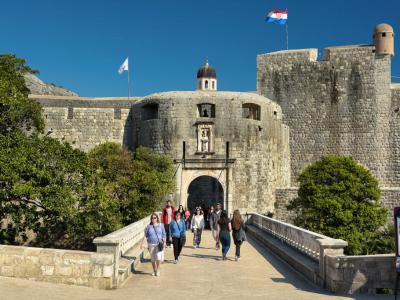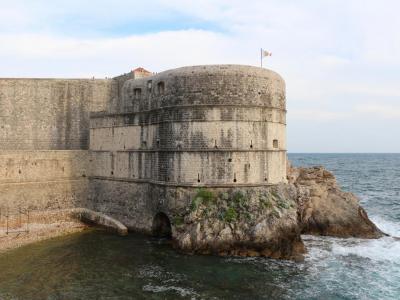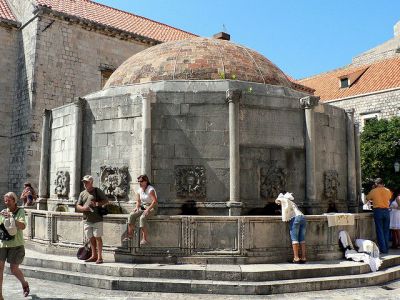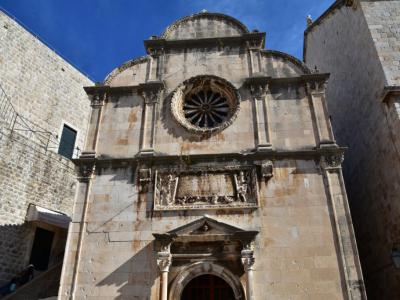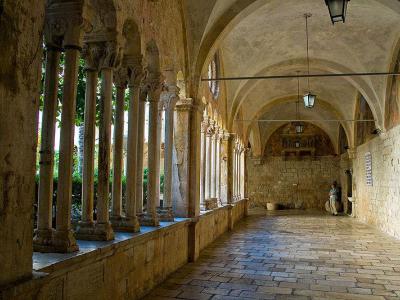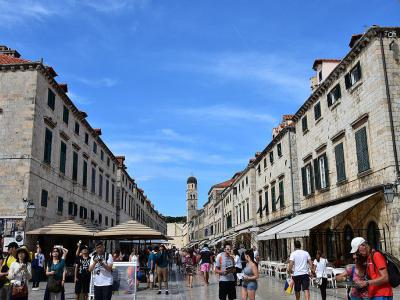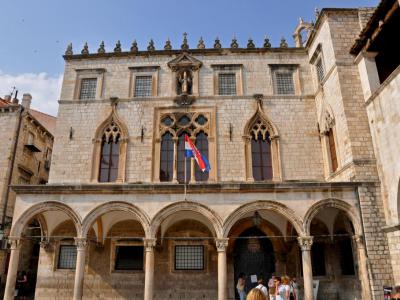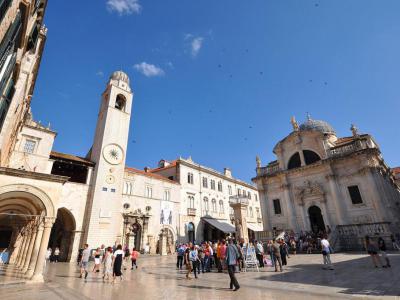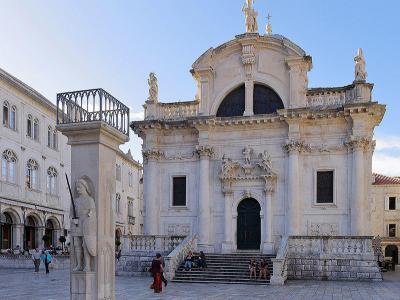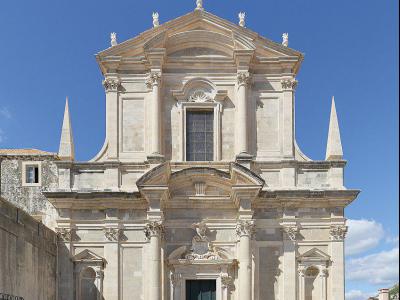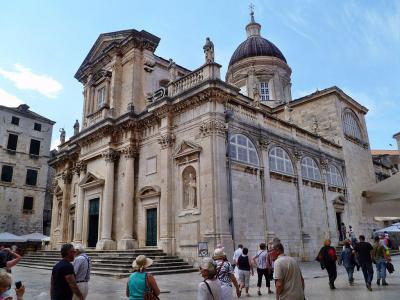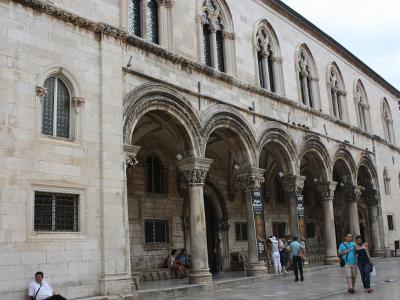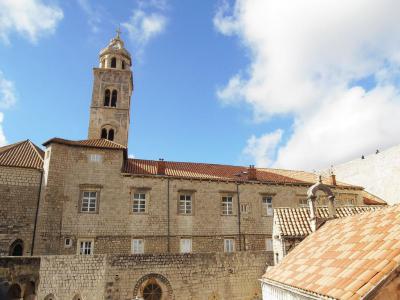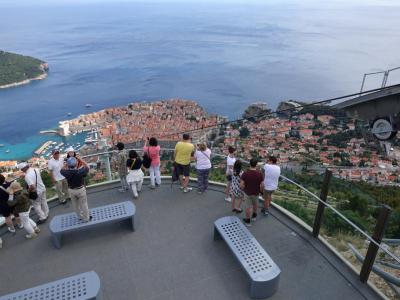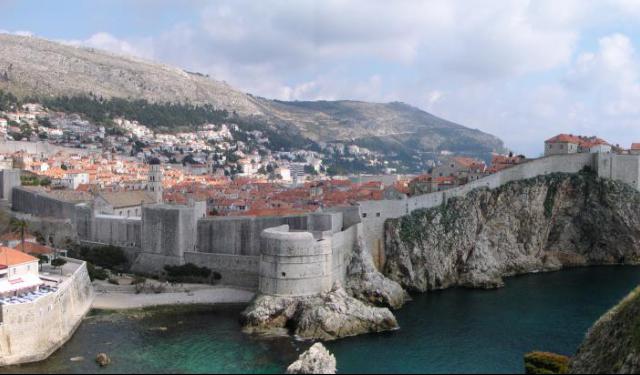
Dubrovnik Introduction Walking Tour (Self Guided), Dubrovnik
One of the most visited cities in Croatia – comfortably situated on the Adriatic coast in the south of the country, Dubrovnik is a major seaport and historical location packed with numerous monuments and points of interest. Since 1979, the city has been listed as the UNESCO World Heritage site.
The history of Dubrovnik dates back to the 7th century, when the town known as Ragusa was founded by refugees from Epidaurum (Ragusa Vecchia). Initially under the protection of the Byzantine Empire and later under the sovereignty of the Republic of Venice, between the 14th and 19th centuries Dubrovnik ruled itself as a free state. The prosperity of the city was historically based on maritime trade; as the capital of the maritime Republic of Ragusa, it achieved a high level of development, particularly during the 15th and 16th centuries, as it became notable for its wealth and skilled diplomacy. At the same time, Dubrovnik became a cradle of Croatian literature.
The entire city was almost destroyed when a devastating earthquake hit in 1667. During the Napoleonic Wars, Dubrovnik was occupied by the French Empire forces, and then the Republic of Ragusa was abolished and incorporated into the Napoleonic Kingdom of Italy and later into Illyrian Provinces. During most of the 19th and 20th centuries, Dubrovnik was a part of the Austrian Empire, Austria-Hungary and then Yugoslavia.
In 1991, during the disintegration of Yugoslavia, Dubrovnik was besieged by the Yugoslav People's Army for seven months and suffered significant damage from shelling. After undergoing repair and restoration works in the 1990s and early 2000s, it re-emerged as one of the Mediterranean's top tourist destinations, as well as a popular filming location, especially known for the HBO television series Game of Thrones.
The latter, in large part, was due to the picturesque Old Town of Dubrovnik, encircled with massive stone walls completed in the 16th century. Its well-preserved buildings range from Baroque St. Blaise's Church to Renaissance Sponza Palace to the Gothic Rector’s Palace, which is currently a history museum. Paved with limestone, the pedestrianized Stradun (or Placa) is lined with multiple shops and restaurants. To explore these and other most famous attractions of Dubrovnik, take this self-guided introduction tour.
The history of Dubrovnik dates back to the 7th century, when the town known as Ragusa was founded by refugees from Epidaurum (Ragusa Vecchia). Initially under the protection of the Byzantine Empire and later under the sovereignty of the Republic of Venice, between the 14th and 19th centuries Dubrovnik ruled itself as a free state. The prosperity of the city was historically based on maritime trade; as the capital of the maritime Republic of Ragusa, it achieved a high level of development, particularly during the 15th and 16th centuries, as it became notable for its wealth and skilled diplomacy. At the same time, Dubrovnik became a cradle of Croatian literature.
The entire city was almost destroyed when a devastating earthquake hit in 1667. During the Napoleonic Wars, Dubrovnik was occupied by the French Empire forces, and then the Republic of Ragusa was abolished and incorporated into the Napoleonic Kingdom of Italy and later into Illyrian Provinces. During most of the 19th and 20th centuries, Dubrovnik was a part of the Austrian Empire, Austria-Hungary and then Yugoslavia.
In 1991, during the disintegration of Yugoslavia, Dubrovnik was besieged by the Yugoslav People's Army for seven months and suffered significant damage from shelling. After undergoing repair and restoration works in the 1990s and early 2000s, it re-emerged as one of the Mediterranean's top tourist destinations, as well as a popular filming location, especially known for the HBO television series Game of Thrones.
The latter, in large part, was due to the picturesque Old Town of Dubrovnik, encircled with massive stone walls completed in the 16th century. Its well-preserved buildings range from Baroque St. Blaise's Church to Renaissance Sponza Palace to the Gothic Rector’s Palace, which is currently a history museum. Paved with limestone, the pedestrianized Stradun (or Placa) is lined with multiple shops and restaurants. To explore these and other most famous attractions of Dubrovnik, take this self-guided introduction tour.
How it works: Download the app "GPSmyCity: Walks in 1K+ Cities" from Apple App Store or Google Play Store to your mobile phone or tablet. The app turns your mobile device into a personal tour guide and its built-in GPS navigation functions guide you from one tour stop to next. The app works offline, so no data plan is needed when traveling abroad.
Dubrovnik Introduction Walking Tour Map
Guide Name: Dubrovnik Introduction Walking Tour
Guide Location: Croatia » Dubrovnik (See other walking tours in Dubrovnik)
Guide Type: Self-guided Walking Tour (Sightseeing)
# of Attractions: 15
Tour Duration: 2 Hour(s)
Travel Distance: 1.8 Km or 1.1 Miles
Author: emma
Sight(s) Featured in This Guide:
Guide Location: Croatia » Dubrovnik (See other walking tours in Dubrovnik)
Guide Type: Self-guided Walking Tour (Sightseeing)
# of Attractions: 15
Tour Duration: 2 Hour(s)
Travel Distance: 1.8 Km or 1.1 Miles
Author: emma
Sight(s) Featured in This Guide:
- Pile Gate
- Fort Bokar
- Large Onofrio's Fountain
- Saint Saviour's Church
- Franciscan Monastery & Museum
- Stradun Street
- War Photo Limited
- Sponza Palace
- Luža Square
- Saint Blaise's Church
- Saint Ignatius Church
- Dubrovnik Cathedral and Treasury
- Rector's Palace
- Dominican Monastery and Museum
- Dubrovnik Cable Car
1) Pile Gate (must see)
"Kill them, kill them all!" King Joffrey is under attack by an angry mob when he returns to Red Keep. But wait. There is no King Joffrey and there is no Red Keep. This is actually season two, episode 6 of the TV series, "Game of Thrones." The "Red Keep" is Pile Gate, the main entrance to the old walled city of Dubrovnik, Croatia.
The name Pile is derived from the Greek word "pylaj", meaning "gate." Most walking tours of the Old City start at the 15th-century Pile Gate. It is a good starting point for a walk on the city walls as well. The gate is located on the western side of the walls. It leads directly to Stradun Street, the main promenade of Dubrovnik.
Pile Gate is actually made up of two gates. The inner gate was built in 1460. The outer gate dates from 1537. The Pile Gate complex is defended by the Cylindrical Fort Bokar and the formidable moat that ran around the outside of the inner wall. The moat today is dry. It is a ribbon of landscaped parkland between the two walls.
A stone bridge with Gothic arches at each end, designed by architect Paskoje Milicevic in 1471, connects to a wooden drawbridge inserted over the moat. At night, the drawbridge would be raised to block the gateway. A Romanesque statue of the patron Saint Blaise is above the gateway arch. He holds a model of the city in one hand.
The entire Old City is enclosed in a veritable curtain of stone. The walls are 6,373 feet long and as much as 82 feet high in some places. The landside wall is supported by 10 circular bastions and a casemate fortress. The two main entrances to the city are The Pile Gate in the west and the Polce Gate in the east.
*** Game of Thrones Tour ***
The Pile Gate has been featured in a number of episodes of Game of Thrones Seasons 2 and 3, most notably in Season 2, Episode 6 ‘The Old Gods and the New’. In a scene where King Joffrey returns to Red Keep after Marcella is sent away to Dorne, he gets attacked by the angry mob gathered at the entrance and screams ‘Kill them, kill them all’. The Gate also shows in Season 3, Episode 10 ‘Mhysa’ when Jamie Lannister returns to King’s Landing.
The name Pile is derived from the Greek word "pylaj", meaning "gate." Most walking tours of the Old City start at the 15th-century Pile Gate. It is a good starting point for a walk on the city walls as well. The gate is located on the western side of the walls. It leads directly to Stradun Street, the main promenade of Dubrovnik.
Pile Gate is actually made up of two gates. The inner gate was built in 1460. The outer gate dates from 1537. The Pile Gate complex is defended by the Cylindrical Fort Bokar and the formidable moat that ran around the outside of the inner wall. The moat today is dry. It is a ribbon of landscaped parkland between the two walls.
A stone bridge with Gothic arches at each end, designed by architect Paskoje Milicevic in 1471, connects to a wooden drawbridge inserted over the moat. At night, the drawbridge would be raised to block the gateway. A Romanesque statue of the patron Saint Blaise is above the gateway arch. He holds a model of the city in one hand.
The entire Old City is enclosed in a veritable curtain of stone. The walls are 6,373 feet long and as much as 82 feet high in some places. The landside wall is supported by 10 circular bastions and a casemate fortress. The two main entrances to the city are The Pile Gate in the west and the Polce Gate in the east.
*** Game of Thrones Tour ***
The Pile Gate has been featured in a number of episodes of Game of Thrones Seasons 2 and 3, most notably in Season 2, Episode 6 ‘The Old Gods and the New’. In a scene where King Joffrey returns to Red Keep after Marcella is sent away to Dorne, he gets attacked by the angry mob gathered at the entrance and screams ‘Kill them, kill them all’. The Gate also shows in Season 3, Episode 10 ‘Mhysa’ when Jamie Lannister returns to King’s Landing.
2) Fort Bokar
Fort Bokar, also known as Zvjezdan, was conceived as a defensive asset for the Pile Gate of Dubrovnik. Along with Minceta Tower, it is one of the main defense points of the western land approaches to the city. It was designed by Italian architect Michelozzo di Bartolomeo. The fort was started in 1461 and upgraded in 1570.
It is a two-story casemate-type fort. Its shape is cylindrical and it projects its volume almost entirely from the medieval stone walls. Part of the fort stands on arched supports on the jagged, detached rock. The sea washes beneath the fort as it has for more than 500 years.
These days, the fort is open all year round. It is well known as the venue for performances of the Dubrovnik Summer Festival. Every year between July 10th and August 25th the Renaissance-Baroque city provides at least 70 open-air venues for programs of classical music, opera, drama, and ballet. Fort Bokar is one of these venues.
The fortress has been featured in seasons two and three of Game of Thrones. The Fortress is a half-hour walk from the Old City center. An auto ride from the same place lasts about five minutes.
*** Game of Thrones Tour ***
Fort Bokar frequently appears throughout all seasons of Game of Thrones when they show people walk past the city walls of King's Landing. One of the most memorable scenes is in Season 2, Episode 8, where Tyrion and Lord Varys are looking out at sea discussing the defense strategies for King's Landing with the Red Keep visible in the background.
It is a two-story casemate-type fort. Its shape is cylindrical and it projects its volume almost entirely from the medieval stone walls. Part of the fort stands on arched supports on the jagged, detached rock. The sea washes beneath the fort as it has for more than 500 years.
These days, the fort is open all year round. It is well known as the venue for performances of the Dubrovnik Summer Festival. Every year between July 10th and August 25th the Renaissance-Baroque city provides at least 70 open-air venues for programs of classical music, opera, drama, and ballet. Fort Bokar is one of these venues.
The fortress has been featured in seasons two and three of Game of Thrones. The Fortress is a half-hour walk from the Old City center. An auto ride from the same place lasts about five minutes.
*** Game of Thrones Tour ***
Fort Bokar frequently appears throughout all seasons of Game of Thrones when they show people walk past the city walls of King's Landing. One of the most memorable scenes is in Season 2, Episode 8, where Tyrion and Lord Varys are looking out at sea discussing the defense strategies for King's Landing with the Red Keep visible in the background.
3) Large Onofrio's Fountain
Enter the Old Town through the Pile Gate to Stradun Street. On the right-hand side is a sixteen-sided cylindrical-like stone structure with sixteen water taps. The polygonal stone tank is capped with a reddish brick cupola. This is the terminus of the town aqueduct system known as the Large Onofrio's Fountain.
The fountain was designed in 1438 by the Neapolitan architect Onofrio di Giordano della Cava. He planned the town's waterworks and fountains. He built the Large Fountain by Pile Gate and the smaller one in Luza Square. He also constructed a 7.5-mile-long supply system from Knezica Spring directly to the Old Town.
The Large Onofrio's Fountain has one stone-carved mask ("maskeron") in each of the 16 large panels. A statue of a dog named "Kuchak," meaning "fountain dog," adorns the top of the fountain walls. Kuchak is a replica of the original, badly damaged in the earthquake of 1667. The fountain was another location used in TV's Game of Thrones.
The town fountains were the main source of potable water until the end of the 19th century. They still provide clean, drinkable water today. The Large Onofrio's Fountain location by the Church of Saint Saviour is also a popular meeting place for visitors and locals.
The fountain was designed in 1438 by the Neapolitan architect Onofrio di Giordano della Cava. He planned the town's waterworks and fountains. He built the Large Fountain by Pile Gate and the smaller one in Luza Square. He also constructed a 7.5-mile-long supply system from Knezica Spring directly to the Old Town.
The Large Onofrio's Fountain has one stone-carved mask ("maskeron") in each of the 16 large panels. A statue of a dog named "Kuchak," meaning "fountain dog," adorns the top of the fountain walls. Kuchak is a replica of the original, badly damaged in the earthquake of 1667. The fountain was another location used in TV's Game of Thrones.
The town fountains were the main source of potable water until the end of the 19th century. They still provide clean, drinkable water today. The Large Onofrio's Fountain location by the Church of Saint Saviour is also a popular meeting place for visitors and locals.
4) Saint Saviour's Church
A devastating earthquake shook Dubrovnik on May 17, 1520. About twenty people were killed, and several buildings suffered heavy damage. The local senate of the Republic of Ragusa in Dubrovnik decided that while it was bad, it could have been worse. Out of gratitude for divine forbearance, they called for a small votive church to be built.
Architect Petar Andrijić, from the island of Korcula, received the commission in 1520. The church of Saint Saviour, dedicated to Jesus Christ, is located near Pile Gate. It has one nave and a Gothic ribbed vault ceiling. The slender side windows have Gothic pointed arches. Still, the front facade shows Renaissance motifs.
The three-leaf curved top of the upper level and the semicircular apse are certainly Renaissance elements. The main portal archway is flanked by slender columns supporting a triangular pediment. The entablature above bears an inscription in Latin expressing gratitude to God that the town had been spared even worse destruction.
In 1667 Dubrovnik was hit harder than ever by another quake. Around 5,000 people were killed, and much of the city was flattened. But Saint Saviour's Church was miraculously spared. Even its elegant rose window survived intact. The church remains today as it was in 1667, emerging unmarred amid disaster.
Architect Petar Andrijić, from the island of Korcula, received the commission in 1520. The church of Saint Saviour, dedicated to Jesus Christ, is located near Pile Gate. It has one nave and a Gothic ribbed vault ceiling. The slender side windows have Gothic pointed arches. Still, the front facade shows Renaissance motifs.
The three-leaf curved top of the upper level and the semicircular apse are certainly Renaissance elements. The main portal archway is flanked by slender columns supporting a triangular pediment. The entablature above bears an inscription in Latin expressing gratitude to God that the town had been spared even worse destruction.
In 1667 Dubrovnik was hit harder than ever by another quake. Around 5,000 people were killed, and much of the city was flattened. But Saint Saviour's Church was miraculously spared. Even its elegant rose window survived intact. The church remains today as it was in 1667, emerging unmarred amid disaster.
5) Franciscan Monastery & Museum (must see)
The document dating from 1235 mentions the Franciscan Monastery of Saint Thomas in the Pile suburb of Dubrovnik. The monastery was demolished and re-established within the city walls in 1317 under threats of war with King Uros II of Serbia. After the quake of 1667, the church was renovated in the Baroque style.
The monastery complex is grandiose. There are two cloisters. The upper one is Renaissance, with arches and semicircular vaults. The lower cloister is a combination of Romanesque and Gothic elements. A courtyard is surrounded by galleries of arches with double columns, having capitals with flora, fauna, and geometric embellishments.
The cloister was built by architect Mihoje Brajkov of Bar in the early 13th century. It has 120 columns and 12 enormous pilasters. A fountain and statue of Saint Francis is in the center of the cloister. The well-preserved Minor Friars Pharmacy has inventory from 1317. It has furnishings from Siena and Florence from the 15th and 16th centuries.
Other exhibits in the museum include presses, mortars, scales, a 14th-century still, and rare manuscripts. The Museum Library holds copies of medieval manuscripts, chorales, and highly valued paintings by forgotten masters. There is a 14th-century head relic of St. Ursula and an assortment of ex-voto jewelry (a collection of one-of-a-kind and limited edition pieces designed by Elizabeth from antique elements).
The monastery complex is grandiose. There are two cloisters. The upper one is Renaissance, with arches and semicircular vaults. The lower cloister is a combination of Romanesque and Gothic elements. A courtyard is surrounded by galleries of arches with double columns, having capitals with flora, fauna, and geometric embellishments.
The cloister was built by architect Mihoje Brajkov of Bar in the early 13th century. It has 120 columns and 12 enormous pilasters. A fountain and statue of Saint Francis is in the center of the cloister. The well-preserved Minor Friars Pharmacy has inventory from 1317. It has furnishings from Siena and Florence from the 15th and 16th centuries.
Other exhibits in the museum include presses, mortars, scales, a 14th-century still, and rare manuscripts. The Museum Library holds copies of medieval manuscripts, chorales, and highly valued paintings by forgotten masters. There is a 14th-century head relic of St. Ursula and an assortment of ex-voto jewelry (a collection of one-of-a-kind and limited edition pieces designed by Elizabeth from antique elements).
6) Stradun Street (must see)
Stradun or Placa is the limestone-paved pedestrianized Main Street of Dubrovnik. It extends to around 1,000 feet through the walled Old Town. In the 13th century, a swampy channel ran where Stradun Street is today. The street reaches neatly in an east-west direction between the western Pile Gate to Ploce Gate in the east.
The Large Onofrio's Fountain and the Franciscan Monastery are found by Pile Gate. The Small Onofrio's Fountain and the Dubrovnik Bell Tower are at the other end of the street by Ploce Gate. Stradun's current appearance is the result of rebuilding after the devastating earthquake of 1667.
The buildings lining the street today are all "of a size" rather uniform in design. Before the quake, houses on the street had arcades and were elaborately decorated. Most were destroyed by the fire that followed the earthquake. After all the quaking and burning, the Republic generated laws regulating housing construction in the city.
So, the 13th-century street has 17th-century housing. Ground levels were designed with shop fronts under a semicircular arch. The first floor (2nd floor USA) was meant as a living space. The floors above held extra rooms and a kitchen loft.
Stradun has become a favorite esplanade for tourists. Processions and events are held in the street. The Feast of Saint Blaise, the patron saint of the city, passes through on the 3rd of February. There are concerts at other times and of course, New Year's Eve.
The best way to see Stradun is to walk the street. Take a seat at one of the many cafes. Have a drink and watch the passing throng. The steps of Saint Blaise Church offer a good vantage point. Then there's always Orlando's Column in Luza Square.
Erected in 1418, the knight Orlando stands with a sword and shield in a niche. Some say Orlando defeated Saracen pirates in the eighth century. It's only a legend, but Orlando is a monument to the freedom of Dubrovnik.
The Large Onofrio's Fountain and the Franciscan Monastery are found by Pile Gate. The Small Onofrio's Fountain and the Dubrovnik Bell Tower are at the other end of the street by Ploce Gate. Stradun's current appearance is the result of rebuilding after the devastating earthquake of 1667.
The buildings lining the street today are all "of a size" rather uniform in design. Before the quake, houses on the street had arcades and were elaborately decorated. Most were destroyed by the fire that followed the earthquake. After all the quaking and burning, the Republic generated laws regulating housing construction in the city.
So, the 13th-century street has 17th-century housing. Ground levels were designed with shop fronts under a semicircular arch. The first floor (2nd floor USA) was meant as a living space. The floors above held extra rooms and a kitchen loft.
Stradun has become a favorite esplanade for tourists. Processions and events are held in the street. The Feast of Saint Blaise, the patron saint of the city, passes through on the 3rd of February. There are concerts at other times and of course, New Year's Eve.
The best way to see Stradun is to walk the street. Take a seat at one of the many cafes. Have a drink and watch the passing throng. The steps of Saint Blaise Church offer a good vantage point. Then there's always Orlando's Column in Luza Square.
Erected in 1418, the knight Orlando stands with a sword and shield in a niche. Some say Orlando defeated Saracen pirates in the eighth century. It's only a legend, but Orlando is a monument to the freedom of Dubrovnik.
7) War Photo Limited (must see)
The Museum of War Photo Limited is located just off Stradun in the center of the Old Town. It is open only from April through October. The War Photos fill two floors with exhibits. These are photojournalistic displays featuring recent and current global and regional conflicts. The images are moving, but some material may be disturbing.
The idea of the museum is to show the realities of war through photography. The images are sometimes raw and terrifying, without any aesthetics or ideals. The exhibition depicts wars and conflicts around the globe in Afghanistan, Sierra Leone, Iraq, and Croatia. Images brightly lit on dark walls range from stark violence to absurdity.
The second floor contains a permanent exhibition of the effects of war on Croatia and Dubrovnik following the disintegration of Yugoslavia. War Photo Limited is without a political agenda or goals. Their self-proclaimed mission is to collect and exhibit photographic images of modern wars without regard to any emotional impact.
The idea of the museum is to show the realities of war through photography. The images are sometimes raw and terrifying, without any aesthetics or ideals. The exhibition depicts wars and conflicts around the globe in Afghanistan, Sierra Leone, Iraq, and Croatia. Images brightly lit on dark walls range from stark violence to absurdity.
The second floor contains a permanent exhibition of the effects of war on Croatia and Dubrovnik following the disintegration of Yugoslavia. War Photo Limited is without a political agenda or goals. Their self-proclaimed mission is to collect and exhibit photographic images of modern wars without regard to any emotional impact.
8) Sponza Palace
"Our weights do not allow cheating. When I measure goods, God measures with me." An inscription on an arch in the Sponza Palace in the Old Town carries this declaration in Latin. The palace is also called Divona ("customs"). Built-in the 16th century, its name is derived from the Latin "spongia", meaning a rainwater catchment.
The rectangular building shows a mixture of Gothic and Renaissance elements. It was designed by architect Paskoja Milicevic Mihov somewhere between 1516 and 1522. The ground floor fronting Luza Square has a Renaissance portico of five arches supported by slender Corinthian columns with floral capitals.
Stone masonry was carried out by the brothers Josip and Nikola Andrijic from the island of Korcula. The facade expresses a harmonic styling arrangement. The Renaissance arcade is on the ground floor, Gothic triforiums are on the upper floor, and Renaissance windows are on the top floor, with an alcove holding a statue of Saint Blaise.
The Sponza Palace survived the 1667 earthquake intact. It was built as a customs house and has done service as a mint, treasury, armory, and bank. The rooms around the atrium hold an exhibit of documents dating from the 11th century. The Memorial Room of Defenders is a tribute to the victims and heroes of the 1990s wars.
The rectangular building shows a mixture of Gothic and Renaissance elements. It was designed by architect Paskoja Milicevic Mihov somewhere between 1516 and 1522. The ground floor fronting Luza Square has a Renaissance portico of five arches supported by slender Corinthian columns with floral capitals.
Stone masonry was carried out by the brothers Josip and Nikola Andrijic from the island of Korcula. The facade expresses a harmonic styling arrangement. The Renaissance arcade is on the ground floor, Gothic triforiums are on the upper floor, and Renaissance windows are on the top floor, with an alcove holding a statue of Saint Blaise.
The Sponza Palace survived the 1667 earthquake intact. It was built as a customs house and has done service as a mint, treasury, armory, and bank. The rooms around the atrium hold an exhibit of documents dating from the 11th century. The Memorial Room of Defenders is a tribute to the victims and heroes of the 1990s wars.
9) Luža Square
Walk through the Pile Gate to enter the Old Town. The Stradun stretches from west to east to the far end at Luza Square and Polce Gate. Luza Square is relatively small, but it houses several key landmarks of the Old Town. It holds the Sponza Palace, the Clock Tower, the Church of Saint Blaise, Orlando's Column, and Onofrio's Small Fountain.
Also present on the square are the City Cafe (Gradska Kavana), Theatre Marin Drzic, the Rector's Palace, Dubrovnik Cathedral, and the facade of Saint Blaise's Church. The square is busy with tourists and events today, but it has been used in the past for proclamations, trials, punishments, and executions.
The Sponza Palace adjoins the Bell Tower, which connects to a gateway to the harbor. The City Guard building stands by Onofrio's Small Fountain. The bronze statue of Renaissance playwright Marin Drzic, the "Shakespeare" of Dubrovnik, sits before his eponymous theatre and the Rector's Palace museum.
The Cathedral and Treasury are near the entrance to the Gundulic Square morning market. Since the Middle Ages, Luza Square has been the venue for the Dubrovnik Summer Festival and the Feast of Saint Blaise. To avoid crowds, go early in the summer and late in the winter.
Also present on the square are the City Cafe (Gradska Kavana), Theatre Marin Drzic, the Rector's Palace, Dubrovnik Cathedral, and the facade of Saint Blaise's Church. The square is busy with tourists and events today, but it has been used in the past for proclamations, trials, punishments, and executions.
The Sponza Palace adjoins the Bell Tower, which connects to a gateway to the harbor. The City Guard building stands by Onofrio's Small Fountain. The bronze statue of Renaissance playwright Marin Drzic, the "Shakespeare" of Dubrovnik, sits before his eponymous theatre and the Rector's Palace museum.
The Cathedral and Treasury are near the entrance to the Gundulic Square morning market. Since the Middle Ages, Luza Square has been the venue for the Dubrovnik Summer Festival and the Feast of Saint Blaise. To avoid crowds, go early in the summer and late in the winter.
10) Saint Blaise's Church (must see)
Saint Blaise, "Sveti Vlaho" in Croatian, is known as a martyr, a protector of animals, and a miracle worker. The patron saint of Dubrovnik, he once saved the city from a Venetian attack in 971 through a vision to Stojko, a canon of Saint Stephen's Cathedral. Saint Blaise's Church in Luza Square is dedicated to him.
The church was built in 1715 by Venetian architect Marino Groppelli. The building was erected on the foundations of a medieval Romanesque church. The church has a single nave and a ground plan formed as a Greek Cross, a cross with arms of equal length. The apse is flanked by two sacristies. An oblong cupola is in the middle.
The lower facade is set off by four Corinthian columns. Two of the columns flank the main portal. The remaining two are at the edges of the facade. The upper level of the facade is a semicircular gable and a balustrade. A statue of Saint Blaise is at the top of the gable. The figures of Faith and Hope stand at the sides.
The barrel-vaulted interior is lavishly Baroque. There are Corinthian columns in the center. The main altar is of white and multi-colored marble. In a niche is a 15th-century Gothic-style statue of Saint Blaise. He holds a model of the previous Romanesque church destroyed by fire in the earthquake of 1667.
The church was built in 1715 by Venetian architect Marino Groppelli. The building was erected on the foundations of a medieval Romanesque church. The church has a single nave and a ground plan formed as a Greek Cross, a cross with arms of equal length. The apse is flanked by two sacristies. An oblong cupola is in the middle.
The lower facade is set off by four Corinthian columns. Two of the columns flank the main portal. The remaining two are at the edges of the facade. The upper level of the facade is a semicircular gable and a balustrade. A statue of Saint Blaise is at the top of the gable. The figures of Faith and Hope stand at the sides.
The barrel-vaulted interior is lavishly Baroque. There are Corinthian columns in the center. The main altar is of white and multi-colored marble. In a niche is a 15th-century Gothic-style statue of Saint Blaise. He holds a model of the previous Romanesque church destroyed by fire in the earthquake of 1667.
11) Saint Ignatius Church (must see)
The Church of Saint Ignatius is located in Ruder Boskovic Field, reached by climbing steps designed after the famed Spanish Steps of Rome by architect Pietro Passalacqua. The church is built as a Jesuit church in the Roman Baroque style. It was completed in 1725 as a single-nave church and designed by Ignazio Pozzo.
Baroque frescoes inside showing the life of Saint Ignatius are the work of artist Gaetano Garcia. In 1885 a cave was created in the church dedicated to Our Lady of Lourdes. The cave was painted by the Jesuit master Antonio Moscheni. There are balconies and boxes on each side. Daylight through the stained-glass roof illuminates all within.
The facade is characterized by a High Baroque aesthetic. The central zone has free-standing columns and an ornate portal adorned with sculpted angels by architect Marino Groppelli. Next to the church is the Jesuit Collegium, built in 1662 and rebuilt in 1669-1725 after the devastating earthquake of 1667.
The Collegium was where the world-famous scholar Ruder Boskovic once taught. Today it is home to the Classical Gymnasium High School of Dubrovnik.
Baroque frescoes inside showing the life of Saint Ignatius are the work of artist Gaetano Garcia. In 1885 a cave was created in the church dedicated to Our Lady of Lourdes. The cave was painted by the Jesuit master Antonio Moscheni. There are balconies and boxes on each side. Daylight through the stained-glass roof illuminates all within.
The facade is characterized by a High Baroque aesthetic. The central zone has free-standing columns and an ornate portal adorned with sculpted angels by architect Marino Groppelli. Next to the church is the Jesuit Collegium, built in 1662 and rebuilt in 1669-1725 after the devastating earthquake of 1667.
The Collegium was where the world-famous scholar Ruder Boskovic once taught. Today it is home to the Classical Gymnasium High School of Dubrovnik.
12) Dubrovnik Cathedral and Treasury
In 1192, returning from the Third Crusade, Richard I of England survived a shipwreck off the island of Lokrum, near present-day Dubrovnik. As an offering of gratitude, Richard pledged to fund two churches. One of them was the Romanesque Cathedral of the Assumption of the Virgin Mary in Dubrovnik.
Richard's cathedral was destroyed in the earthquake of 1667. The Senate of Dubrovnik commissioned Italian architect Andrea Bufalini to rebuild. He developed a Baroque model church with a nave, two aisles, and a cupola. Friar Tommaso Napoli of Palermo added a cross vault and large windows on the upper level.
The portal on the facade is flanked by Corinthian columns. A central Baroque window is in a triangular gable with a balustrade and statues of saints. Niches hold statues of Saint Blaise and Saint Joseph with Child.
The interior has a high nave with two aisles separated by massive columns. There are three apses and a dome where the nave and transepts meet. The main altar has a polyptych by Titian from 1552 of the Assumption of Mary. The side altars hold paintings by both Italian and Dalmatian masters.
The Cathedral Treasury has 182 reliquaries with relics from the 11th to the 18th century. The reliquaries were created by local artists and masters from Byzantium, Venice, and Asia Minor. The featured relics are the gold-plated arm, leg, and skull of Saint Blaise. There is also a piece of the True Cross.
Richard's cathedral was destroyed in the earthquake of 1667. The Senate of Dubrovnik commissioned Italian architect Andrea Bufalini to rebuild. He developed a Baroque model church with a nave, two aisles, and a cupola. Friar Tommaso Napoli of Palermo added a cross vault and large windows on the upper level.
The portal on the facade is flanked by Corinthian columns. A central Baroque window is in a triangular gable with a balustrade and statues of saints. Niches hold statues of Saint Blaise and Saint Joseph with Child.
The interior has a high nave with two aisles separated by massive columns. There are three apses and a dome where the nave and transepts meet. The main altar has a polyptych by Titian from 1552 of the Assumption of Mary. The side altars hold paintings by both Italian and Dalmatian masters.
The Cathedral Treasury has 182 reliquaries with relics from the 11th to the 18th century. The reliquaries were created by local artists and masters from Byzantium, Venice, and Asia Minor. The featured relics are the gold-plated arm, leg, and skull of Saint Blaise. There is also a piece of the True Cross.
13) Rector's Palace (must see)
Initially, the 13th-century Rector's Palace was built as living quarters for the Rector to stay in for the duration of his one-month term. During this time he was allowed to leave only for official functions. Spouses and family had to stay elsewhere. He was the daily keeper of the keys to the city gates.
In addition to being the Rector's residence pro tem, the palace also served as the headquarters of the Republic Major and Minor Councils, the main arsenal, and the city prison. There was access to the courtroom and the Great Council Palace. It was all business, no place for family.
Located just south of Luza Square, the palace, like the city, has been ravaged many times by wars, earthquakes, fires, and sieges. Its style is Gothic, with reconstructions involving Renaissance and Baroque influences. The palace got its current form, including the atrium and front portico, after the explosion of 1463.
The western facade entrance features a portico with carved columns and capitals. The loggia has marble benches for public seating. The interior atrium and courtyard have rows of Corinthian columns and a Baroque staircase leading to the mezzanine gallery.
Below the staircase is a small 15th-century fountain and a statue by sculptor Piero Paolo Giacometti erected in 1638. The statue honors Miho Pracat, a wealthy citizen who left his entire estate to the Republic. The atrium has splendid acoustics. It is frequently the venue for concerts held at the Dubrovnik Summer Festival.
Today, the Rector's Palace is home to the Museum of Dubrovnik. The exhibitions show artifacts from the city's history, furniture, portraits, seals, crests, and coins. The keys to the city gates are still here, together with archives of Republic Council meetings. The old pharmacy and its 15th-century House of Christ ("Domus Christi") artifacts are here.
The Rector's Palace is managed and operated by the Museum of Dubrovnik since 1872.
In addition to being the Rector's residence pro tem, the palace also served as the headquarters of the Republic Major and Minor Councils, the main arsenal, and the city prison. There was access to the courtroom and the Great Council Palace. It was all business, no place for family.
Located just south of Luza Square, the palace, like the city, has been ravaged many times by wars, earthquakes, fires, and sieges. Its style is Gothic, with reconstructions involving Renaissance and Baroque influences. The palace got its current form, including the atrium and front portico, after the explosion of 1463.
The western facade entrance features a portico with carved columns and capitals. The loggia has marble benches for public seating. The interior atrium and courtyard have rows of Corinthian columns and a Baroque staircase leading to the mezzanine gallery.
Below the staircase is a small 15th-century fountain and a statue by sculptor Piero Paolo Giacometti erected in 1638. The statue honors Miho Pracat, a wealthy citizen who left his entire estate to the Republic. The atrium has splendid acoustics. It is frequently the venue for concerts held at the Dubrovnik Summer Festival.
Today, the Rector's Palace is home to the Museum of Dubrovnik. The exhibitions show artifacts from the city's history, furniture, portraits, seals, crests, and coins. The keys to the city gates are still here, together with archives of Republic Council meetings. The old pharmacy and its 15th-century House of Christ ("Domus Christi") artifacts are here.
The Rector's Palace is managed and operated by the Museum of Dubrovnik since 1872.
14) Dominican Monastery and Museum
The Dominican Monastery of Dubrovnik was established in 1315. Much of its original funding came from the local government. In addition, many local builders volunteered to help the Dominican Order to get established in the city. Sadly, the building sustained great damage during the 1667 earthquake and had to be rebuilt in places.
It is a classic example of a Gothic cloister adjoined by a working medieval well and an old bell tower that combines various architectural styles, from Romanesque to Baroque.
A special treasure of the Dominican monastery is the library with 216 incunabula, numerous illustrated manuscripts, a rich archive with precious manuscripts and documents, plus an extensive art collection. There is a statue of St. Dominique, the founder of the Dominican Order. Also deserve mentioning are the newer Gothic arch and the statue of Christ.
The monastery campus is an example of one of the first multi-faceted construction projects in the city. Part of it is a cute little museum located off a small passageway behind the Sponza Palace, which, sadly, many visitors tend to miss. The museum is dedicated to preserving and displaying religious art from Dubrovnik. The collection includes some remarkably well-preserved paintings, church vessels, and triptychs, as well as a reliquary purportedly containing the skull of King Stephen I of Hungary.
Tip:
Buy the Dubrovnik one-day ticket that gives you access to several museums, including this monastery.
It is a classic example of a Gothic cloister adjoined by a working medieval well and an old bell tower that combines various architectural styles, from Romanesque to Baroque.
A special treasure of the Dominican monastery is the library with 216 incunabula, numerous illustrated manuscripts, a rich archive with precious manuscripts and documents, plus an extensive art collection. There is a statue of St. Dominique, the founder of the Dominican Order. Also deserve mentioning are the newer Gothic arch and the statue of Christ.
The monastery campus is an example of one of the first multi-faceted construction projects in the city. Part of it is a cute little museum located off a small passageway behind the Sponza Palace, which, sadly, many visitors tend to miss. The museum is dedicated to preserving and displaying religious art from Dubrovnik. The collection includes some remarkably well-preserved paintings, church vessels, and triptychs, as well as a reliquary purportedly containing the skull of King Stephen I of Hungary.
Tip:
Buy the Dubrovnik one-day ticket that gives you access to several museums, including this monastery.
15) Dubrovnik Cable Car
To enjoy the best possible view of Dubrovnik and the surrounding area, make sure to get yourself on top of the Srd Mountain, 778 meters above sea level. The best way to reach it, undoubtedly, is the Dubrovnik Cable Car. One of the city's top attractions, it was built in 1969 and has since been enthusiastically used by millions of tourists anxious to capture the breathtaking panoramas of the Adriatic Sea, Dubrovnik's Old Town, and the neighboring islands.
On a clear day, this vantage point affords a view as far as 60 km (37 miles) away. No wonder that the nearby Imperial Fortress, built in the early 19th century by none other than Napoleon Bonaparte himself, precisely in time for his birthday, was strategically placed in this privileged position. The best time to take photos is around sunset.
The cable car line employs two carriages, each carrying up to 30 people, making regular three-minute runs to the top of the Mount. Once up there, you may also want to visit the Museum of Homeland War, featuring original documents, artifacts, and authentic photo and video materials related to the Balkan armed conflict of 1991-1995. Also, at the upper Cable Car station, there are a restaurant, café, and a souvenir shop.
Tip:
The most convenient way to buy tickets is directly at the cable car stations. Payments can be made either in cash – with Croatian kuna only (no foreign currencies accepted) – or by credit cards.
On a clear day, this vantage point affords a view as far as 60 km (37 miles) away. No wonder that the nearby Imperial Fortress, built in the early 19th century by none other than Napoleon Bonaparte himself, precisely in time for his birthday, was strategically placed in this privileged position. The best time to take photos is around sunset.
The cable car line employs two carriages, each carrying up to 30 people, making regular three-minute runs to the top of the Mount. Once up there, you may also want to visit the Museum of Homeland War, featuring original documents, artifacts, and authentic photo and video materials related to the Balkan armed conflict of 1991-1995. Also, at the upper Cable Car station, there are a restaurant, café, and a souvenir shop.
Tip:
The most convenient way to buy tickets is directly at the cable car stations. Payments can be made either in cash – with Croatian kuna only (no foreign currencies accepted) – or by credit cards.
Walking Tours in Dubrovnik, Croatia
Create Your Own Walk in Dubrovnik
Creating your own self-guided walk in Dubrovnik is easy and fun. Choose the city attractions that you want to see and a walk route map will be created just for you. You can even set your hotel as the start point of the walk.
Historical Churches
Throughout history, Dubrovnik’s citizens have had plenty of causes to ask God for help. And when they got it, they never forgot to express their gratitude. Oftentimes, it came in the form of newly built churches; hence an array of religious landmarks, some truly magnificent, found in the Old Town, constructed over the centuries.
One such architectural marvel is Saint Saviour's Church,... view more
Tour Duration: 1 Hour(s)
Travel Distance: 0.8 Km or 0.5 Miles
One such architectural marvel is Saint Saviour's Church,... view more
Tour Duration: 1 Hour(s)
Travel Distance: 0.8 Km or 0.5 Miles
Game of Thrones Filming Sites Tour
Dubrovnik has no shortage of picturesque sights: colorful roofs with terracotta tiles, impressive stone architecture, high-rising cliffs, and a stunning Old Town wall overlooking the wild Adriatic. It is mostly for this reason that the city was chosen as the main filming location for King's Landing, a fictional city in the world-famous TV series "Game of Thrones." If you're a... view more
Tour Duration: 2 Hour(s)
Travel Distance: 2.7 Km or 1.7 Miles
Tour Duration: 2 Hour(s)
Travel Distance: 2.7 Km or 1.7 Miles
City Walls Walking Tour
Gazing down at the fortified city, you see a treasure trove of Gothic and Renaissance churches, monasteries, Venetian palaces and ornately carved fountains. They’re all crammed together with shuttered apartments, hole-in-the-wall boutiques and outdoor restaurants and cafés.
There are three different entrances to the Dubrovnik walls. One is at Pile Gate, one is at Ploce Gate (near the... view more
Tour Duration: 2 Hour(s)
Travel Distance: 2.4 Km or 1.5 Miles
There are three different entrances to the Dubrovnik walls. One is at Pile Gate, one is at Ploce Gate (near the... view more
Tour Duration: 2 Hour(s)
Travel Distance: 2.4 Km or 1.5 Miles
The Most Popular Cities
/ view all
